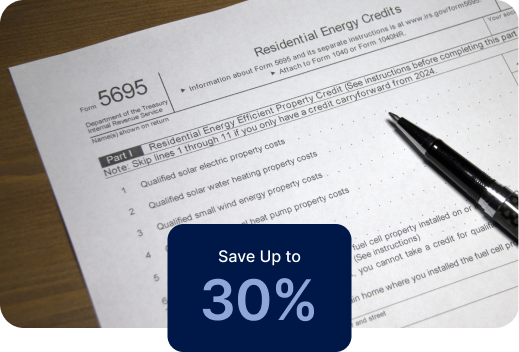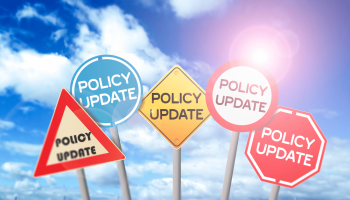The renewable energy sector continues to expand, despite policy uncertainty under the Trump administration.
Wisconsin Solar Incentives: 2025 Overview
Wisconsin provides strong incentives to make solar energy affordable. Homeowners can benefit from the 30% Residential Clean Energy Credit, and many utilities in the state offer net metering, allowing residents to earn credits for excess energy, and lowering future bills. With additional rebates from local utilities, going solar in Wisconsin is a smart way to…

Residential Clean Energy Credit
The Clean Electricity Investment Credit (previously called the Federal Investment Tax Credit) helps lower the cost of installing solar panels by 30%. This credit covers everything: the solar panels, equipment, labor, permits, and even sales tax.
For example, as of 2025 the average cost of a 10 kW solar system in the U.S. typically ranges between $21,000 and $29,500 before applying any federal tax incentives. After claiming the 30% Clean Electricity Investment Credit, the price drops to around $14,980 to $21,070, depending on the state and other factors like equipment quality and labor costs.
To claim this credit, you must buy your solar system with cash or a loan (leases don’t qualify). You also need to owe enough in taxes to claim the credit, but if you don’t, you can carry it over to future years until 2034.

Claiming the Clean Electricity Investment Credit is simple!
Step 1
Print IRS Form 3468
Step 2
Fill out the form using info from your installer
Step 3
Submit it when you file your taxes
What are the top solar incentives in Wisconsin?
Besides the Clean Electricity Investment Credit (former ITC), homeowners can take advantage of several outstanding incentives that significantly enhance the return on investment for solar panels. Here are some of the most effective ways to lower your solar installation costs.
Incentive
Savings
Summary
Residential Renewable Energy Tax Credit
A taxpayer may claim a credit of 30% of qualified expenditures, after deducting incentives, with no upper limit for a system that serves a dwelling unit located in the United States that is owned and used as a residence by the taxpayer. Expenditures with respect to the equipment are treated as made when the installation is completed. If the installation is at a new home, the “placed in service” date is the date of occupancy by the homeowner. Expenditures include labor costs for on-site preparation, assembly or original system installation, and for piping or wiring to interconnect a system to the home. If the federal tax credit exceeds tax liability, the excess amount may be carried forward to the succeeding taxable year. The excess credit may be carried forward until 2020, but it is unclear whether the unused tax credit can be carried forward after then.
Clean Power Partner Solar Buyback Program
Customer-generators enrolled in the Madison Gas & Electric (MGE) green power purchase program (Green Power Tomorrow) are eligible to receive a special rate for the power produced from solar photovoltaic (PV) systems. Under this program, the electricity produced from 1 to 10 kilowatt (kW-DC) PV systems will be purchased by MGE at a rate of $0.25/kilowatt-hour (kWh). This rate will apply to all electricity produced by the system. As the program is limited to Green Power Tomorrow participants, customers will purchase electricity from the utility at the normal retail rate plus the green power premium (currently $0.0125/kWh).
Residential Renewable Energy Tax Credit
A taxpayer may claim a credit of 22% of qualified expenditures, after deducting incentives, with no upper limit for a system that serves a dwelling unit located in the United States that is owned and used as a residence by the taxpayer. Expenditures with respect to the equipment are treated as made when the installation is completed. If the installation is at a new home, the “placed in service” date is the date of occupancy by the homeowner. Expenditures include labor costs for on-site preparation, assembly or original system installation, and for piping or wiring to interconnect a system to the home. If the federal tax credit exceeds tax liability, the excess amount may be carried forward to the succeeding taxable year. The excess credit may be carried forward until 2021, but it is unclear whether the unused tax credit can be carried forward after then.
Residential Renewable Energy Tax Credit
A taxpayer may claim a credit of 26% of qualified expenditures, after deducting incentives, with no upper limit for a system that serves a dwelling unit located in the United States that is owned and used as a residence by the taxpayer. Expenditures with respect to the equipment are treated as made when the installation is completed. If the installation is at a new home, the “placed in service” date is the date of occupancy by the homeowner. Expenditures include labor costs for on-site preparation, assembly or original system installation, and for piping or wiring to interconnect a system to the home. If the federal tax credit exceeds tax liability, the excess amount may be carried forward to the succeeding taxable year. The excess credit may be carried forward until 2019, but it is unclear whether the unused tax credit can be carried forward after then.
Residential Solar PV Incentive
Focus on Energy provides information, financial assistance, technical assistance and other services to residents, businesses, schools, institutions and local governments on energy efficiency and renewable energy. Financial assistance takes the form of rebates, grants and loans. The program was initially created by Act 9 of 1999 as a public benefit fund (PBF), which also provided energy assistance programs for low-income residents.
Rural Residential Customer Solar PV Incentives
Focus on Energy provides information, financial assistance, technical assistance and other services to residents, businesses, schools, institutions and local governments on energy efficiency and renewable energy. Financial assistance takes the form of rebates, grants and loans. The program was initially created by Act 9 of 1999 as a public benefit fund (PBF), which also provided energy assistance programs for low-income residents. Residential Customer Solar PV Incentives for Single Family Home is $500 per system. A Rural residential customers can receive an additional $500 for installing a system.
Residential Renewable Energy Tax Credit
A taxpayer may claim a credit of 30% for the installation which was between 2022-2032 (Systems installed on or before December 31, 2019 were also eligible for a 30% tax credit), with no upper limit for a system that serves a dwelling unit located in the United States that is owned and used as a residence by the taxpayer. Expenditures with respect to the equipment are treated as made when the installation is completed. If the installation is at a new home, the placed in service date is the date of occupancy by the homeowner. Expenditures include labor costs for on-site preparation, assembly or original system installation, and for piping or wiring to interconnect a system to the home.
Residential Customer Solar PV Rebate
Focus on Energy provides information, financial assistance, technical assistance and other services to residents, businesses, schools, institutions and local governments on energy efficiency and renewable energy. Financial assistance takes the form of rebates, grants and loans.Rural residential customers can receive an additional $500 for installing a system.Systems purchased and installed between January 1, 2023, and December 31, 2023, are eligible for funding under the 2023 program year only.
Residential Solar PV Incentive
Focus on Energy provides information, financial assistance, technical assistance and other services to residents, businesses, schools, institutions and local governments on energy efficiency and renewable energy. Financial assistance takes the form of rebates, grants and loans. The program was initially created by Act 9 of 1999 as a public benefit fund (PBF), which also provided energy assistance programs for low-income residents.
Residential Solar PV Incentive
Focus on Energy provides information, financial assistance, technical assistance and other services to residents, businesses, schools, institutions and local governments on energy efficiency and renewable energy. Financial assistance takes the form of rebates, grants and loans. The program was initially created by Act 9 of 1999 as a public benefit fund (PBF), which also provided energy assistance programs for low-income residents.
Rural Residential Customer Solar PV Incentives
Focus on Energy provides information, financial assistance, technical assistance and other services to residents, businesses, schools, institutions and local governments on energy efficiency and renewable energy. Financial assistance takes the form of rebates, grants and loans. The program was initially created by Act 9 of 1999 as a public benefit fund (PBF), which also provided energy assistance programs for low-income residents. Residential Customer Solar PV Incentives for Single Family Home is $500 per system. A Rural residential customers can receive an additional $500 for installing a system.
Renewable Energy Grant
Dunn Energy is offering incentives on installation of member-owned renewable energy projects. Member will have 6 months from the date issued to use the grant. Funds will not be paid until project completion. Funds cannot exceed 25% of the project cost. Incentive amount is capped at $1000.
Renewable Energy Grant
Dunn Energy is offering incentives on installation of member-owned renewable energy projects. Member will have 6 months from the date issued to use the grant. Funds will not be paid until project completion. Funds cannot exceed 25% of the project cost. Incentive amount is capped at $1500.
Residential Photovoltaic System
Only items that were purchased and installed between Jan. 1, 2020 and Dec. 31, 2020 are eligible.Required documentation (listed on rebate form) needs to be submitted to the Co-op office within THREE months of purchase/installation. Rebates are only available while funds last. Once the funds allocated for 2020 rebates are depleted, rebates will not be issued.Review the rebate form to make sure all items and certifications are submitted in order for the form to be reviewed.
Solar PV Rebate Program
The solar electric (PV) rebate is $250 per kW for residential customers. Polk-Burnett pays up to $750 for qualifying wind/solar interconnected grid projects.
Solar PV Rebate Program
The solar electric (PV) rebate is $200 per kW for residential customers. Polk-Burnett pays up to $600 for qualifying wind/solar interconnected grid projects.
Renewable Energy Grant
JREC wants to assist cooperative members interested in owning and installing a renewable generation system. Renewable energy grant incentive will be paid out at $200 per installed kW of the system up to $2000 max. JREC reserves the right to award no grants if the projects do not meet the above guidelines.
Renewable Energy Grant
JREC wants to assist cooperative members interested in owning and installing a renewable generation system. Renewable energy grant incentive will be paid out at $200 per installed kW of the system up to $2000 max. JREC reserves the right to award no grants if the projects do not meet the above guidelines.
Distributed Solar Tariff
River Falls Municipal Utilities (RFMU), a member of WPPI Energy, offers a special energy purchase rate to its customers that generate electricity using solar photovoltaic (PV) systems. The special rate, $0.30/kilowatt-hour (kWh), is available to all the RFMU customers on a first-come, first-served basis for systems up to 4 kilowatts (kW). The RFMU program is part of a larger solar buyback program being offered by WPPI to its member utilities, which has a total program limit of 300 kW. RFMU was originally allocated 10 kW for their tariff, but because of the program’s popularity, that limit has been increased several times, and is now limited to 30 kW. As of May 2013, the program has 14.4 kW of solar installed with an additional 12 kW in queue for installation.
Solar Energy Incentive
RFMU matches the Focus on Energy incentive for solar up to $1000. All projects must be approved by Focus on Energy to receive an RFMU incentive
Disclaimer: The information provided here regarding solar incentives, tax credits, and rebates is for general informational purposes only and may vary based on your specific circumstances. For exact details, eligibility requirements, and current rates, we recommend consulting a certified solar installer or a tax professional. Incentives can differ by location, utility provider, and individual project, so it’s important to get personalized advice for your solar installation. Always verify the most up-to-date information from your local solar installer to understand how these incentives apply to your project.
Knowledge Base
Find everything you need to know about solar in your state and nationwide

Get a Quote
Discover the Ideal Solar System for Your Home in Just a Few Clicks!







